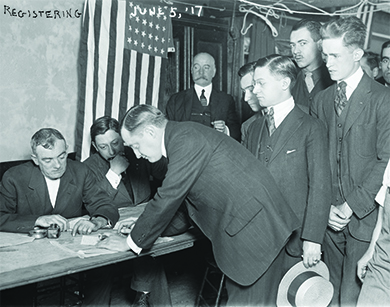| << Chapter < Page | Chapter >> Page > |
Wilson knew that the key to America’s success in war lay largely in its preparation. With both the Allied and enemy forces entrenched in battles of attrition, and supplies running low on both sides, the United States needed, first and foremost, to secure enough men, money, food, and supplies to be successful. The country needed to first supply the basic requirements to fight a war, and then work to ensure military leadership, public support, and strategic planning.
The First World War was, in many ways, a war of attrition, and the United States needed a large army to help the Allies. In 1917, when the United States declared war on Germany, the U.S. Army ranked seventh in the world in terms of size, with an estimated 200,000 enlisted men. In contrast, at the outset of the war in 1914, the German force included 4.5 million men, and the country ultimately mobilized over eleven million soldiers over the course of the entire war.
To compose a fighting force, Congress passed the Selective Service Act in 1917, which initially required all men aged twenty-one through thirty to register for the draft ( [link] ). In 1918, the act was expanded to include all men between eighteen and forty-five. Through a campaign of patriotic appeals, as well as an administrative system that allowed men to register at their local draft boards rather than directly with the federal government, over ten million men registered for the draft on the very first day. By the war’s end, twenty-two million men had registered for the U.S. Army draft. Five million of these men were actually drafted, another 1.5 million volunteered, and over 500,000 additional men signed up for the navy or marines. In all, two million men participated in combat operations overseas. Among the volunteers were also twenty thousand women, a quarter of whom went to France to serve as nurses or in clerical positions.
But the draft also provoked opposition, and almost 350,000 eligible Americans refused to register for military service. About 65,000 of these defied the conscription law as conscientious objectors, mostly on the grounds of their deeply held religious beliefs. Such opposition was not without risks, and whereas most objectors were never prosecuted, those who were found guilty at military hearings received stiff punishments: Courts handed down over two hundred prison sentences of twenty years or more, and seventeen death sentences.

With the size of the army growing, the U.S. government next needed to ensure that there were adequate supplies—in particular food and fuel—for both the soldiers and the home front. Concerns over shortages led to the passage of the Lever Food and Fuel Control Act, which empowered the president to control the production, distribution, and price of all food products during the war effort. Using this law, Wilson created both a Fuel Administration and a Food Administration. The Fuel Administration, run by Harry Garfield, created the concept of “fuel holidays,” encouraging civilian Americans to do their part for the war effort by rationing fuel on certain days. Garfield also implemented “daylight saving time” for the first time in American history, shifting the clocks to allow more productive daylight hours. Herbert Hoover coordinated the Food Administration, and he too encouraged volunteer rationing by invoking patriotism. With the slogan “food will win the war,” Hoover encouraged “Meatless Mondays,” “Wheatless Wednesdays,” and other similar reductions, with the hope of rationing food for military use ( [link] ).

Notification Switch
Would you like to follow the 'U.s. history' conversation and receive update notifications?